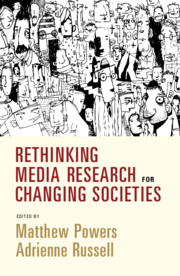Book contents
- Rethinking Media Research for Changing Societies
- Communication, Society and Politics
- Rethinking Media Research for Changing Societies
- Copyright page
- Contents
- Figure
- Contributors
- Acknowledgments
- 1 Introduction
- Part I Living in a Datafied World
- Part II Journalism in Times of Change
- 4 Press Freedom and Its Context
- 5 What Are Journalists for Today?
- 6 Noise and the Values of News
- Part III Media and Problems of Inclusion
- Part IV Engagement with and through Media
- Part V The Role of Scholars
- Other Books in the Series (continued from page ii)
- References
6 - Noise and the Values of News
from Part II - Journalism in Times of Change
Published online by Cambridge University Press: 18 September 2020
- Rethinking Media Research for Changing Societies
- Communication, Society and Politics
- Rethinking Media Research for Changing Societies
- Copyright page
- Contents
- Figure
- Contributors
- Acknowledgments
- 1 Introduction
- Part I Living in a Datafied World
- Part II Journalism in Times of Change
- 4 Press Freedom and Its Context
- 5 What Are Journalists for Today?
- 6 Noise and the Values of News
- Part III Media and Problems of Inclusion
- Part IV Engagement with and through Media
- Part V The Role of Scholars
- Other Books in the Series (continued from page ii)
- References
Summary
This chapter poses the question of whether news values can serve a contemporary media environment that is chaotic, crowded and noisy. Drawing on examples from the 2016 American presidential campaign, Stephanie Craft and Morten Stinus Kristensen argue that norms of impact, conflict and novelty are increasingly incompatible with a media environment that demands and rewards sharing news incrementally and repeatedly, treating every new piece of information with breaking news intensity. These mismatched values are further fueled by commercial pressures that favor such values, as well as by bad faith actors who seek to game these values to steer coverage in ways that promote their causes or muddy public understanding of core issues. Rather than advocating for a return to a romanticized simpler time of journalistic gatekeeping power and professional authority over news, Craft and Kristensen argue that journalists and journalism educators need to rethink some of the basic premises of journalistic norms and practices, with the aim of developing news values better able to provide publics with the information necessary for political life to function.
- Type
- Chapter
- Information
- Rethinking Media Research for Changing Societies , pp. 78 - 88Publisher: Cambridge University PressPrint publication year: 2020
References
- 1
- Cited by



